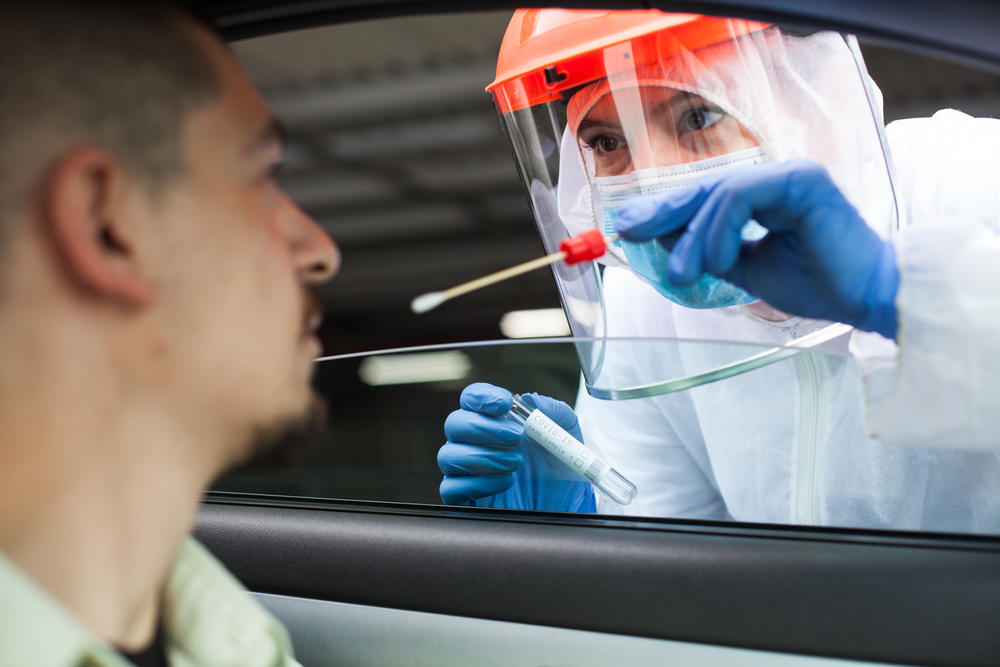As a car, truck, or minivan pulls into the COVID-19 testing tent, you become a part of someone’s COVID story.
These patients show a lifetime of emotions. Although separated by glass, you see gestures of generosity and prayer. Acts of kindness and compassion are demonstrated as a loved one or friend holds someone’s hand or taps their thigh or shoulder. Those in the car—families, couples, friends, adult children with parents, children with parents or grandparents—all share this story. You see people from 6 months to 99 years, giving you cross-generational view.
As you greet those in the car, you try to make eye contact. You may give a slight wave, smile, or nod of your head. Immediately, you see fear, anxiety, or nervous behavior through the glass. Sometimes your patients have curious eyes as they look at your PPE; others avoid eye contact completely. You see a patient’s support or a patient alone, with look of confidence or fright.
After removing the biohazardous bag from the windshield wiper and double-checking the initials on the window with the test requisition and label, you prepare your swab and test vial. You can feel the patient’s eyes watching you as you motion for the window to come down.
Speaking over the vacuum cleaner hum of your power air purifying respirator (PAPR), you motion with your eyes and hands for the patient to remove their mask, look forward, look up and put their head back. Then you insert a swab into their nose. You hope the swab finds no resistance until you meet the turbinates. You provide some pressure on the swab and gently swirl the swab out.
As you swab, the faces of the young and old often tighten until tears fill their eyes. You anticipate a cough, sneeze, or gag from your patient, along with a slight movement of their head away from your hand. Your hope is you have soaked the swab with enough protein to obtain a “good” specimen.
When the swab is completed, many patients shake their heads and open their eyes as if they were exiting a cold plunge. Some give a yell, and others just rub their nose and eyes to rid themselves of that uncomfortable feeling before putting their mask back on.
You say “close your window” as you walk away, insert the swab into the vial, tighten the vial cap, and put the specimen into the biohazardous bag.
You then approach the car, motioning for the window to be opened so you can give discharge instructions. You then say “I hope you feel better,” motion for the window to be closed, and wave the car out of the testing tent.
Many want to talk, ask questions, and share their story with you. They say why they are there, they want to know how they will get their results, or they simply want to thank you again. Again, you motion windows up and wave them on and out of the tent.
In the tent our job is to obtain the nasal pharyngeal specimen with while limiting exposure of the virus; it takes about 90 seconds. There is no time to complete a nursing history or conversation. As you watch the car pull out of the tent, you sanitize your hands, wipe your workstation down, and prepare for the next patient.
As the nurse, at a COVID-19 testing station, you never know the patient’s entire story. When did they develop symptoms? Have they had exposure to the virus? Is a family member, friend, or coworker sick, hospitalized, or dead from COVID-19? Does the patient understand social distancing and quarantine? Are they able to practice these actions? Have they been affected by the financial fall out can they afford to be off from work?
Your nursing assessment is limited to a visual view as you are separated by glass.
In the early weeks of COVID-19 Testing, I saw patients who looked dusky, pale, and sweaty. Some patients had respiratory rates nearing 40/minute and a radial pulse well over 100. For some we advised a visit to the emergency department at our hospital only a few miles away. For others, we called the emergency medical system for transport to the hospital. I often wonder how those patients story continued.
We are in our seventh week of testing at this the station and have completed over 5,000 tests. We have worked in rain, snow, and hail (with winds upwards of 60 mph) and with temperatures ranging from 30 to 60 degrees F. Our staff has received many thank-you notes on social media and compliments along the way.
As nurses on the front line, we know we have made a difference. That alone is not enough. Each day we leave the station with a feeling of emptiness, wishing our nursing assessment and interventions were not separated by glass.
A special thanks to the County of Morris, Department of Law and Public Safety, Office of Emergency Management, Sheriff’s Department, Park Police, Fire Academy, Department of Health, and Morris County Medical Corp. for their support every day at the station.
Karen Jean Feury is an injury prevention coordinator for Morristown Medical Center in Morristown, New Jersey.



















3 Comments.
An interesting perspective on yet another side of the Covid-19 nursing experience.
A very compelling outlook on the value of the nursing assessment and history or lack thereof, demonstrating the astute value of nursing experience and skill in directing interventions appropriately to home, hospital, or ambulance.
Excellent story KJ. The Nurses in this very important mission have done a phenomenal job under less than ideal circumstance. That’s what Nurses do. We owe you all a great deal of gratitude. God Bless you all. Excellent Leadership KJ. You make us all better people.
Thank you for sharing this touching recount of screening in the community. KJ Feury is an expert APN, manager and nurse leader. Her logistical expertise and ability to collaborate was evident; but, these skills never overshadowed her quest to humanize the short experience with individuals.
Thank you KJ for all you do!